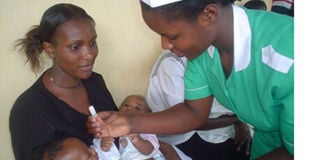Infant mortality rates high in Busoga, says survey

A nurse immunises children. Suc incentives can reduce infant mortality. File photo
Jinja- Ms Juliana Nabwire, a resident of Buwekula Village, Mafubira Sub-county in Jinja District, delivered twin baby boys from Jinja Regional Referral Hospital in February but her happiness was short-lived when they all passed on due to infections.
The death of these twins and many other babies in Busoga Sub-region, points to an infant mortality rate that is currently higher than the national figure.
According to a 2017 survey conducted by Makerere University Excellence for Maternal, Newborn and Child Health under Makerere University School of Public Health, neonatal mortality rate in Busoga Sub-region stands at 28 of every 1,000 live births against the national figure of 27 of 1,000 live births.
Infant mortality rate stands at 53 of every 1,000 live births against the national figure of 43 out of 1000 live births, and under five mortality rate is at 84 of 1000 births against the national figure of 64 of 1,000 children.
Prof Peter Waiswa, an associate at Makerere University School of Public Health, attributed the increase in infant mortality rates to the few public hospitals in the sub-region.
“Busoga Sub-region comprising of 10 districts with a population of three million people has only four public hospitals yet its fertility rate is high [with six children per woman against the national figure of five children] and the use of contraceptives is at 30 per cent,” Prof Waiswa said.
He added: “This has created congestion in the health facilities, forcing health workers to discharge mothers and their babies before recovering to create space for others.”
Prof Waiswa also attributed the deaths to increased cases of malnutrition and malaria, saying the sub-region is surrounded by rivers, lakes and wetlands.
“Following the health demographic survey, 53 per cent of the children in Busoga suffer from malaria. Government has been investing in the Northern region through residual spraying and Busoga has been neglected,’’ he said.
He added: “50 per cent of the children are anemic because of malnutrition; the stunting rate is almost 30 per cent and the total immunisation coverage of Busoga is 45 per cent.”
Ms Gertrude Namazzi, a researcher at Makerere University School of Public Health, attributed the high newborn death rates to poor quality care at health facilities within the sub-region.
She said 80 per cent of the newborn death rates [neonatal deaths] which occur between the ages of 1 to 28 days are due to failure to breathe at the time of birth, infections and preterm birth complications.
Ms Namazzi called for the need to improve the quality of services at health facilities.
The officer in-charge Buluguyi Health Centre III in Bugiri District, Dr Geoffrey Wakooli, said most midwives are not skilled or competent enough to conduct deliveries.
The Namayingo Resident District Commissioner, Mr Sylvester Obera, said the poor referral system in the country has contributed to high maternal and infant mortality rate.
Jinja hospital says
The head of pediatrics at Jinja Regional Referral Hospital, Dr Abner Tagoola, said as health workers, they must embrace innovation to improve on the referral system. “We are currently predominately working on a WhatsApp group to conduct referrals from Kaliro District to Jinja Referral Hospital. The health worker will alerts and 20 minutes before arrival, everything will be set to save the baby’s life,’’ Dr Tagoola disclosed.




